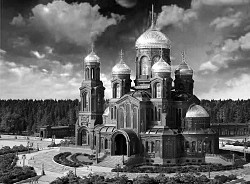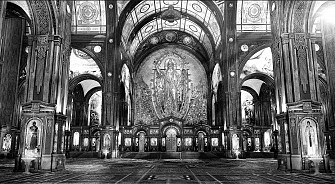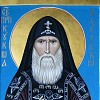I would like to share my thoughts in connection with the discussion that has unfolded around the decoration of the mosaics of the main Church of the Armed Forces of Russia, recently built in Moscow.
Since ancient times, temples and entire monasteries dedicated to various historical events have always been erected on Russian soil. Such churches and monasteries include the following: the Church of the Protection on the Nerl, the Sretensky Monastery, the Kazan Cathedral on Red Square, the Cathedral of Saint Vladimir in Sevastopol, which is called the "Admiral's Cathedral" of the Russian fleet, where Admirals Lazarev, Kornilov, Nakhimov and Istomin are buried. The names of all naval officers who fell during the defense of Sevastopol are engraved on marble slabs in the upper church of this temple. The churches listed above include the Cathedral of Christ the Savior, built in 1883 in honor of the victory over Napoleon in the Patriotic War of 1812, and the St. Nicholas Cathedral, dedicated to the Russian fleet and all reposed sailors, built from 1903-1913 in Kronstadt. Even now those temples that belonged to a particular military regiment in tsarist times have also been preserved.
As a rule, in addition to icon painting, these temples were also decorated with memorable statues depicting certain historical events, and military paraphernalia, and, of course, with the awards that fallen soldiers received during the war. The naves of such temples usually had marble slabs on which the names of the fallen defenders of the fatherland were engraved. Most of these churches and monasteries were built, as a rule, on donations of ordinary Orthodox people. And this was done primarily so that everyone, making his contribution, would feel this temple, erected with his help, would be a house of prayer: “My house will be called a house of prayer” (Matthew 21:13).
All Orthodox Christians, regardless of their country of residence, have a reverent attitude towards such historical monuments. But if for believers they are places of worship and the sacraments of the Church, for people who do not profess Christianity, the temple is a cultural and historical place. Orthodox Christians, as a rule, come to these temples for prayer and veneration. Tourists coming to these historical temples are shown the internal and external beauty of the church, they are told about its height, length and width. Sometimes they talk briefly about murals, frescoes and mosaics.
Probably many people, from among those interested in history (not to mention Orthodox people who have already expressed their opinion), would be very surprised to see among the mosaics of the new church not only the President of Russia, but also the current Minister of Defense and other representatives of the current government. In the history of the Church there has been a practice of depicting various Orthodox rulers, clergy and ordinary people involved in the construction of those churches or involved in historical events related to that particular temple.
For us living abroad, the descendants of glorious autocratic Russia, which was stained by the blood of the revolution – destroying in terrible torments by its power the best sons of our homeland – it would be horrible to look at the image of that person whose hands were stained up to his elbows in blood of not only of Christians, but also of all the peoples of Russia. By mistake, the image of this bloody ruler was placed on a fresco of the Cathedral. But at the insistence of sensible rulers and the people, it was dismantled along with some other images. I consciously do not wish to mention his name on the page of this newspaper. Our Lord did this same thing when He called the ruler of Galilee and Perea a fox in the days of His earthly life (Luke 13:31). “A good tree cannot bear bad fruits, nor a bad tree can bear good fruits” (Matt. 7:17).
Although it is not customary in our Christian tradition to speak badly of the departed, we must not forget the atrocities committed by these people. I think that if this mosaic remained, then the road to this temple would have been closed to many people abroad. The wounds of those people whose relatives were shot or sent into exile in the thirties without trial would not be healed. And in Russia itself there are not a few of such people. After all, it was the people in Russia who voice objection, as a result of which several mosaics of the temple will eventually be dismantled. We do not agree with some other symbols found both on the frescoes and in other places of the temple. For all these images, there is a separate place in a gallery built at this temple under the name “The Road of Remembrance”. This is the appropriate place for portraits, orders, weapons and other military objects. This is where there should also be paintings or murals of historical events that are not related to the Second World War.
Each time, when crossing the threshold of the temple, we must remember the words of Christ addressed specifically to us: “Come unto Me all who are weary and heavy laden, and I will give you rest; take My yoke upon you and learn from Me, for I am meek and humble in heart, and you will find rest for your souls; for My yoke is easy, and My burden is light” (Matthew 11: 28-30).
We are not members of the Expert Council on Church Art, Architecture and Restoration. Therefore perhaps our opinion does not coincide with the opinion of this council. But we consider it necessary to express it, because according to St. Gregory the Theologian: "God is betrayed by silence."
+ THEODOSIUS
Bishop of Seattle
First Auxiliary of the Western American Diocese
Russian Life, Saturday June 13, 2020
San Francisco, CA
|
| |||||||||||||













